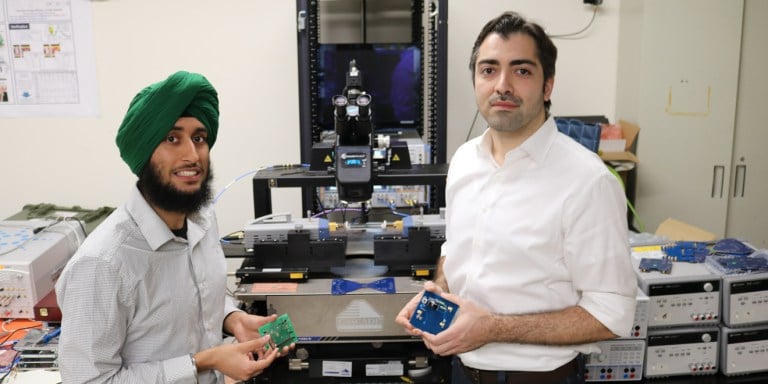It’s not the usual Valentine’s day treat, but today’s audience at the International Solid State Circuits Conference will hear two Stanford researchers present a breakthrough finding that paints a rosy picture of the future of the Internet of Things, a catch-all phrase referring to any network of smart devices. Their work centers around using ultrasonic signals to wake up electronic devices.
Together, electrical engineering assistant professor Amin Arbabian and Ph.D. candidate in electrical engineering Angad Rekhi developed a novel method to turn on electronic devices.
Traditional devices used radio waves to wake up a sleeping device—but by switching to shorter wavelengths and ultrasound waves, Arbabian and Rekhi managed to significantly reduce the amount of power a sleeping device consumes, thereby extending its battery life.
The wake-up receiver listens for a specific pattern of ultrasonic waves indicating to switch on the device. Listening for ultrasonic waves consumes very little power compared to other methods of monitoring when to turn on devices.
The wake-up receiver is particularly useful for building the Internet of Things, which promises to bring everything from your washer to your toaster online. Imagine your fridge generating a shopping list based on its inventory, or the dryer sending you an alert when its load is finished. Communication between devices is vital for the Internet of Things, and wake-up receivers reduce the amount of power required for this crosstalk.
The wake-up receivers use highly sensitive ultrasonic transducers provided by electrical engineering professor Butrus Khuri-Yakub’s lab at Stanford. These transducers convert the ultrasonic signals to electrical input. Altogether, the entire system runs on approximately one nanowatt of power.
Despite the advantages, working with ultrasonic wake-up receivers isn’t easy.
“Scaling down wake-up receivers in size and power consumption while maintaining or extending range is a fundamental challenge,” Arbabian said in an interview with Stanford News.
Still, Arbabian views it as a worthwhile problem.
“Solving this problem can enable scalable networks of wake-up receivers working in our everyday environment,” Arbabian told Stanford News.
Wake-up receivers could usher in the Internet of things by lowering energy costs to the level at which Internet-connected devices become financially feasible.
The Internet of Things is a nascent field, and commercial and academic players are still designing and deciding on the protocols and technology that will become standard in tomorrow’s products. Whether ultrasonic wake-up receivers will be integrated into all of tomorrow’s products remains to be seen, but regardless of its immediate utility, the technology has exciting potential.
“As technology advances, people use it for applications that you could never have thought of,” Rekhi told Stanford News. “I’m excited to see how people will use wake-up receivers to enable the next generation of the Internet of Things.”
Contact Nicholas Midler at midler ‘at’ stanford.edu.
